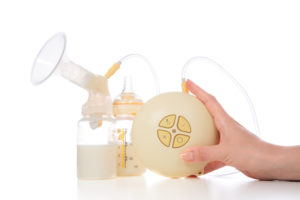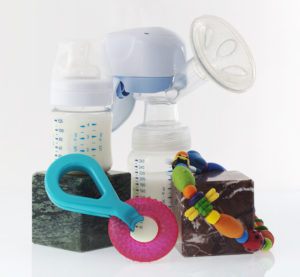One of the biggest sources of anxiety for a newer mom is creating a breast milk bank – but it doesn’t have to be! We’ve all seen the posts on social media of breastfeeding moms with full freezers of overflowing milk. Although it’s great to have so much backup, it also isn’t necessary for a successful breastfeeding relationship.
Some moms are overproducers, while others simply don’t respond as well to the pump. Regardless of your situation, it’s necessary to have a stash when you’re returning to work, even a small one. How, then, do you go about building one?

Building Your Breast Milk Bank
First, recognize that every mom is going to have a different approach to this situation. There are unique factors to this, such as how often your baby is eating, how well you respond to the pump, and how often you’re going to be away from the baby. Maybe you’re working 40 hours a week, or perhaps you’re only gone one-half day.
Keep in mind, too, that you don’t need to have a large stash when you return to work. As long as you have enough for the first day away from the baby and make enough for the following day, and so on, this is completely sufficient. Many moms supplement with formula, either by choice or out of necessity. This should not impact your breastfeeding relationship and does not indicate a failure on your end in any way. If you are thinking about going this direction, speak with an IBCLC to discuss your options.
Should You Pump?
Generally, experts suggest that it’s best to wait to begin pumping until your baby is about four weeks old. However, many moms have pumped since birth without any issues. Often, though, it can trigger an oversupply, which can lead to other issues. When you begin pumping largely depends on when you need to return to work and what kind of stash you’re looking to have.
Many moms report that they feel the most full first thing in the morning. Because of this, one popular strategy for building a stash is to pump after the first morning feed, usually between the hours of 5-7AM.
There is no hard rule for this, though – any earlier morning hour that fits your schedule will suffice. If your baby eats from only one side, pump the other simultaneously while you feed. If your baby takes both sides during your session, pump for 10-20 minutes after your baby is done feeding. It’s best to do this within 15 minutes of ending the feed because you want your body to “think” that your pumping session is a continuation of your same breastfeeding session.
Even this simple trick is enough to begin building a breast milk bank initially. As babies stretch their sleep increments, usually at night, many moms will also pump during a missed feed in addition to the morning feed. For example, if your baby used to sleep from 8PM-10PM but is now waking at 12 AM, if you pump at 10 PM, you are able to contribute that milk to your stockpile.
Choosing A Nursing Bottle
One of the most important parts of pumping is choosing a bottle that’s right for your baby. There is no “wrong” bottle, but many breastfed babies prefer a bottle that mimics a breastfeeding latch as much as possible. Make sure you save your receipts so you don’t end up with a ton of bottles you can’t use. Unfortunately, a lot of finding the right bottle is trial and error to see what your baby will take. We always recommend that unless you’re bottle feeding, don’t register for a complete bottle set at your baby shower for this very reason. You’ll save yourself some frustration. Here are just some of the bottles that breastfeeding moms are raving about – they are a great place to start:
- Lansinoh Momma
- Comotomo
- Munchkin Latch
- Mimijumi

Pace Your Feedings
Another important aspect of bottle feeding a breastfed baby is to do what’s known as paced feeding. Kellymom is a fantastic resource for all things breastfeeding, and her discussion about paced feeding is excellent. The goal of paced feeding is to mimic the breastfeeding session as closely as possible to preserve the breastfeeding relationship.
Here are some tips regarding paced feeding:
- Make sure to feed when the baby is upright
- Feed when the baby exhibits hunger cues and avoid feeding on a strict
schedule
Halfway through the feed, switch from one side to the other to avoid the baby having a preferred side - Make sure to feed appropriate amounts for the breastfed baby; don’t just try feed in larger increments as quickly as possible
- Stroke the baby’s lips as the nipple approaches to stimulate the rooting response Youtube is a great resource for watching a paced feeding.
- Encourage your caregivers to watch a video before feeding your breastfed baby when you return to work. Show your partner, too, so that you can have someone else knowledgeable and on board.
Remember – the gift of breast milk is priceless, whether that is through breastfeeding directly or through a bottle from another caregiver.
Breastfeeding Adjustments When You Go Back To Work
Many moms worry that when they return to work, they will be unable to continue to breastfeed their babies. Don’t let this myth discourage you! Plenty of breastfeeding moms have successfully returned to work and managed to preserve their nursing relationships. Many moms report having evening and night feeds with the baby, as well as an early morning feed before getting ready for work.

When you’re home, keep breastfeeding as much as possible so your baby learns to accept and thrive on both the breast and bottle.
Lots of time and love goes into pumping each and every ounce. Remember these tips when it’s time for you to return to work so you can best preserve your nursing relationship.
We all learn to make certain adjustments so that pumping and works the best for us when we return to work, was there something that allowed you to better build your breast milk bank?






